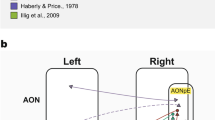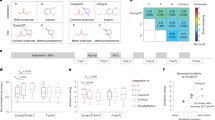Abstract
The sensation and perception of smell (olfaction) are largely dependent on sniffing, which is an active stage of stimulus transport and therefore an integral component of mammalian olfaction1,2. Electrophysiological data obtained from study of the hedgehog, rat, rabbit, dog and monkey indicate that sniffing (whether or not an odorant is present) induces an oscillation of activity in the olfactory bulb, driving the piriform cortex in the temporal lobe, in other words, the piriform is driven by the olfactory bulb at the frequency of sniffing3,4,5,6. Here we use functional magnetic resonance imaging (fMRI) that is dependent on the level of oxygen in the blood to determine whether sniffing can induce activation in the piriform of humans, and whether this activation can be differentiated from activation induced by an odorant. We find that sniffing, whether odorant is present or absent, induces activation primarily in the piriform cortex of the temporal lobe and in the medial and posterior orbito-frontal gyri of the frontal lobe. The source of the sniff-induced activation is the somatosensory stimulation that is induced by air flow through the nostrils. In contrast, a smell, regardless of sniffing, induces activation mainly in the lateral and anterior orbito-frontal gyri of the frontal lobe. The dissociation between regions activated by olfactory exploration (sniffing) and regions activated by olfactory content (smell) shows a distinction in brain organization in terms of human olfaction.
This is a preview of subscription content, access via your institution
Access options
Subscribe to this journal
Receive 51 print issues and online access
$199.00 per year
only $3.90 per issue
Buy this article
- Purchase on Springer Link
- Instant access to full article PDF
Prices may be subject to local taxes which are calculated during checkout




Similar content being viewed by others
References
Le Magnen, J. Etude des facteurs dynamiques de l'excitation olfactive. L'Année Psychologique 77–89 (1945–1946 ).
Laing, D. G. Natural sniffing gives optimum odor perception for humans. Perception 12, 99–117 ( 1983).
Adrian, E. D. Olfactory reactions in the brain of the hedgehog. J. Physiol. 100, 459–473 (1942).
Bressler, S. L. & Freeman, W. J. Frequency analysis of olfactory system EEG in cat, rabbit, and rat. Electro. Clin. Neurophysiol. 50, 19–24 (1980).
Bressler, S. L. Relation of olfactory bulb and cortex. II. Model for driving of cortex by bulb. Brain Res. 409, 294– 301 (1987).
Ueki, S. & Domino, E. F. Some evidence for a mechanical receptor in olfactory function. J. Neurophysiol. 24 , 12–25 (1961).
Jones, A. S., Lancer, J. M., Shone, G. R. & Stevens, J. C. The effect of lignocaine on nasal resistance and nasal sensation of airflow. Acta Otolaryngol. (Stockh.) 101, 328– 330.
Doty, R. L., Shaman, P. & Dann, M. Development of the University of Pennsylvania smell identification test: a standardized microencapsulated test of olfactory function. Physiol. Behav. 32, 489–502 (1984).
Jones, A. S., Wight, R. G., Crosher, R. & Durham, L. H. Nasal sensation of airflow following blockade of the nasal trigeminal afferents. Clin. Otolaryngol. 14, 285– 289 (1989).
Wehr, M. & Laurent, G. Odour encoding by temporal sequences of firing in oscillating neural assemblies. Nature 384, 162–166 (1996).
Price, J. L. in The Human Nervous System (ed. Paxinos, G.) 979– 1001 (Academic, San Diego, 1990).
Price, J. L.et al. in Olfaction, a Model System for Computational Neuroscience (eds Davis, J. L. & Eichenbaum, H.) 101– 120 (MIT Press, Cambridge, MA, 1991).
Zatorre, R. J. & Jones-Gotman, M. Right-nostril advantage for discrimination of odors. Percept. Psychophys. 47, 526–531 (1990).
Zatorre, R. J. & Jones-Gotman, M. Human olfactory discrimination after unilateral frontal or temporal lobectomy. Brain 114, 71–84 ( 1991).
Zatorre, R. J., Jones-Gotman, M., Evans, A. C. & Meyer, E. Functional localization and lateralization of human olfactory cortex. Nature 360, 339–341 ( 1992).
Jones-Gotman, M. & Zatorre, R. J. Olfactory identification deficits in patients with focal cerebral excision. Neuropsychologia 26, 387–400 ( 1988).
Allison, A. C. The secondary olfactory areas in the human brain. J. Anat. 88, 481–488 (1954).
Potter, H. & Nauta, W. J. H. Anote on the problem of olfactory associations of the orbitofrontal cortex in the monkey. Neuroscience 4, 361–367 ( 1979).
Von Bonin, G. & Green, J. R. Connections between orbital cortex and the diencephalon in the macaque. J. Comp. Neurol. 92, 243–254 (1949).
Eslinger, P. J., Damasio, A. R. & Van Hoesen, G. W. Olfactory dysfunction in man: anatomical and behavioral aspects. Brain Cognit. 1, 259– 285 (1982).
Elian, M. Olfactory impairment in motor neuron disease: a pilot study. J. Neurol. Neurosurg. Psychiatr. 54, 927– 928 (1991).
Doty, R. L., Deems, D. A. & Stellar, S. Olfactory dysfunction in Parkinsonism: a general deficit unrelated to neurologic signs, disease stage, or disease duration. Neurology 38, 1237–1244 (1988).
Doty, R. L.et al. Olfactory dysfunction in three neurodegenerative diseases. Geriatrics 46 suppl 1, 47–51 (1991).
Potter, H. & Butters, N. An assessment of olfactory deficits in patients with damage to prefrontal cortex. Neuropsychologia 18, 621–628 ( 1980).
Henkin, R. I., Comiter, H., Fedio, P. & O'Doherty, D. Defects in taste and smell recognition following temporal lobectomy. Trans. Am. Neurol. Assoc. 102, 146–150 (1977).
Sobel, N.et al. Amethod for functional magnetic resonance imaging of olfaction. J. Neurosci. Methods 78, 115– 121 (1997).
Glover, G. H. & Lai, S. Self-navigated spiral fMRI: interleaved versus single-shot. Magn. Reson. Med. 39((1998).
Friston, K. J., Jezzard, P. & Turner, R. Analysis of functional MRI time-series. Hum. Brain Mapp. 1, 153–171 (1994).
Talairach, J. & Tournoux, P. Co-planar Stereotaxic Atlas of the Human Brain (Thieme, Stuttgart, 1988).
Desmond, J. E. & Lim, K. O. On- and offline Talairach registration for structural and functional MRI studies. Hum. Brain Mapp. 5, 58–73 (1997).
Acknowledgements
This work was supported by the Stanford Program in Neuroscience (S.G.F.), Phil & Allen Trust, NIAAA, & NIMH. We thank L. Stryer, B. Wandell, D. Heeger, A. Pfefferbaum, G. Boynton, J.Demb, D. Peterson, G. Heit and J. Wine.
Author information
Authors and Affiliations
Corresponding author
Rights and permissions
About this article
Cite this article
Sobel, N., Prabhakaran, V., Desmond, J. et al. Sniffing and smelling: separate subsystems in the human olfactory cortex . Nature 392, 282–286 (1998). https://doi.org/10.1038/32654
Received:
Accepted:
Issue Date:
DOI: https://doi.org/10.1038/32654
This article is cited by
-
High-precision mapping reveals the structure of odor coding in the human brain
Nature Neuroscience (2023)
-
Respiratory influence on brain dynamics: the preponderant role of the nasal pathway and deep slow regime
Pflügers Archiv - European Journal of Physiology (2023)
-
Neural processing of olfactory-related words in subjects with congenital and acquired olfactory dysfunction
Scientific Reports (2020)
-
Age-associated reorganization of metabolic brain connectivity in Chinese children
European Journal of Nuclear Medicine and Molecular Imaging (2020)
-
Neural processing of odor-associated words: an fMRI study in patients with acquired olfactory loss
Brain Imaging and Behavior (2020)
Comments
By submitting a comment you agree to abide by our Terms and Community Guidelines. If you find something abusive or that does not comply with our terms or guidelines please flag it as inappropriate.



